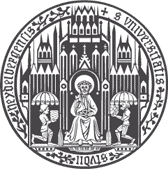Roadmaps for Computational Linguistics:
- "Rechnen mit Sprache? Möglichkeiten und Probleme der
maschinellen Sprachverarbeitung." In Der Deutschunterricht,
Heft 4/1983, S.15-38.
This article is an early account of processing natural languages by computer under semantic aspects.
[Download pdf]
- "Computer – Partner oder Medium?". In: Wolfgang Kühlwein
(Hrsg.): Medientechnik. Kongreßbeiträge zur 15. Jahrestagung
der Gesellschaft für Angewandte Linguistik, GAL e.V. Tübingen 1984. S.46-49.
In Orwell's year 1984 this article raises the question whether computational linguists should design computers as partners of humans or as simple media of communication.
[Download pdf]
- "Weichenstellungen für die maschinelle Sprachverarbeitung
(Plenarvortrag)". In: Angewandte Linguistik und Computer.
Kongreßbeiträge zur 18. Jahrestagung der Gesellschaft
für Angewandte Linguistik, GAL e.V. Hrsg. von B. Spillner.
Tübingen 1988. S. 5 - 35.
This is a survey of achievements and problems of Computational Linguistics in the 80ties.
[Download pdf]
- "Ein theorie-übergreifender Standard für lexikalische
Wissensbasen". In: K.-P. Konerding, A, Lehr (Hrsg.): Linguistische
Theorie und lexikographische Praxis. Symposiumsvorträge,
Heidelberg 1996. Tübingen: Max Niemeyer Verlag 1997
(Lexicographica, Series Maior 82).
Is it possible to build a huge lexical knowledge base which can be
used by numerous applications with divergent theoretical approaches?
The author holds that the common ground for a poly-theoretical lexicon
can only be standards for an empirical taxonomy.
[Download pdf]
- "Computerlinguistik - Was geht, was kommt,
hängt von der Lehre ab." In Gerd Willée, Bernhard
Schröder, Hans-Christian Schmitz (Eds.): Computerlinguistik
- Was geht, was kommt? Sankt Augustin: Gardez! Verlag 2002, S.
138-142. The topic of this Festschrift for Winfried Lenders is the progress
of Computational Linguistics in the future. The author holds that this depends on
the consolidation of education in the field and makes a few proposals.
[Download pdf]
- "Einführung in die Computerlinguistik. Vorlesung mit Übungen. WS 2004/05"
[Download Skript]
[Download Aufgaben]
[Download Lösungen]
Semantics, logical form of natural language, inference:
- "Ein Computermodell für das Folgern in natürlicher
Sprache". In: P. Eisenberg (Hrsg.): Semantik und künstliche
Intelligenz. Beiträge zur automatischen Sprachbearbeitung II.
Berlin, New York 1977. S. 59 - 85.
A model for simulating inferences is described which uses natural
language directly rather than resorting to artificial formalisms.
[Download pdf]
- "Logisch-funktionale Sätze natürlicher Sprache im
Rahmen eines automatischen Deduktionssystem". In: W.U. Dressler, W.
Meid (Hrsg.): Proceedings of the Twelfth International Congress of
Linguists. Vienna, August 28 - September 2, 1977. Innsbruck 1978,
S. 589 - 591.
Generic sentences in natural language can be turned into inference rules.
These rules can be used to build a computational deduction system.
[Download pdf]
Syntactic analysis, grammar theory, dependency grammar:
- "Arbeitspapier: Methoden der Syntaxanalyse."
This is a paper for teaching purposes. It describes empirical methods of a structural
analysis of natural languages. A number of tests is included.
[Download pdf]
- Vorüberlegungen
zur maschinellen Bedeutungsanalyse auf der Grundlage der Valenzidee.
(Dissertation Heidelberg 1974.) Stuttgart: HochschulVerlag 1978.
This book (originally my PhD thesis) deals with formal grammar theory,
the logical form of natural language and computer simulation as a method
of linguistics. Constituency versus dependency, rule-based versus
lexicon-based grammars, functional syntactic categories, and the
role of world knowledge are discussed. A particular grammar formalism
is proposed which is based on valency but copes with constituency at
the same time. It is designed for semantic further processing as well.
The main aim of this formalism is simulating inferences taking place in human communication.
[Download pdf]
- "Dependenzanalyse und Bedeutungspostulate - eine Alternative zur
generativen Transformationsgrammatik". In Linguistische Berichte 52
(1977), S. 32 - 51.
An alternative to the Chomskyan Transformational Grammar is sketched.
The chief goal of TG, namely to account for the meaning relationships
between sentences, is maintained. However the structure of sentences
is decribed in terms of dependency between lexical items rather than
in terms of immediate constituents. The notion of deep structure
is given up. Instead , meaning postulates are introduced as a means
to express various semantic relationships.
[Download pdf]
- "Dependency Unification Grammar (DUG)". In Proceedings of the
11th International Conference on Computational Linguistics (COLING 86).
S. 195 - 198.
The principles of Dependency Unification grammar (DUG) are discussed.
The computer language DRL (Dependency Representation Language) is
introduced in which DUGs can be formulated. A unification-based
parsing procedure is part of the formalism.
[Download pdf]
-
"Dependency Unification Grammar." In: Dependency and Valeny. An International Handbook of
Contemporary Research. Edited by V. Agel, L.M. Eichinger, H.-W. Eroms,
P. Hellwig, H.-J. Heringer, H. Lobin. Volume 1. S. 593-635. Mouton: 2003.
This is the final and comprehensive description of Dependency Unification Grammar (DUG).
[Download pdf]
Natural language parsing, theory and courseware:
- "Chart Parsing According to the Slot and Filler Principle". In Proceedings
of the 12th International Conference on Computational Linguistics
(COLING 88). John von Neumann Society for Computing Sciences
Budapest. Budapest 1988. Vol. I., S. 242-244.
The following choices result in a new parser: The structure to be assigned
to the input is a dependency tree with lexical, morpho-syntactic and
functional-syntactic information. The grammar is lexicalized, i.e.
the syntactical relationships are stated as part of the lexical descriptions
of the elements of the language. The algorithm relies on the slot and
filler principle in order to draw up complex structures. It utilizes
a well-formed substring table (chart) which allows for discontinuous segments.
[Download pdf]
- "Parsing natürlicher Sprachen: Grundlagen" In: Computational
Linguistics. An International Handbook on Computer Oriented Language
Research and Applications. Edited by I. S. Bátori, W.
Lenders, W. Putschke. Berlin: De Gruyter 1989. (Handbücher zur
Sprach- und Kommunikationswissenschaft.) S. 348 - 377.
This chapter aims at a systematic survey of tasks and choices which have to be considered when a parser is designed.
[Download pdf]
- "Parsing natürlicher Sprachen: Realisierungen". In: Computational
Linguistics. An International Handbook on Computer Oriented Language
Research and Applications. Edited by I. S. Bátori, W.
Lenders, W. Putschke. Berlin: De Gruyter 1989. (Handbücher zur
Sprach- und Kommunikationswissenschaft.) S. 378 - 431.
This chapter describes a number of parser prototypes which result from a particular choice between alternative design principles.
[Download pdf]
- "Parsing with Dependency Grammars." In: Dependency and Valeny. An International Handbook of
Contemporary Research. Edited by V. Agel, L.M. Eichinger, H.-W. Eroms,
P. Hellwig, H.-J. Heringer, H. Lobin. Volume 2. S. 1081-1108. Mouton: 2006.
In order to reveal the advantages and disadvantages of the dependency
approach, we proceed from a list of criteria for parsers in general and
then discuss the particular choices which are on hand when dependency
grammars are used.
[Download pdf]
- "Tutorial: Natural Language Parsing - A Course in Cooking." Tutorial at COLING/ACL-98
Montreal. This paper should be read like a cookbook. The reader is encouraged to recombine the various ingredients in order to "cook" a new parser.
[Download newest version pdf]
- "Maschinelle Syntaxanalyse (Parsing). Kurs mit Übungen."
[Download Folien]
[Download Übungen 1]
[Download Übungen 2]
Integrated development environment PLAIN (Programs for Language Analysis and INference):
- "PLAIN - A Program System for Dependency Analysis and for
Simulating Natural Language Inference." In: Leonard Bolc (Ed.): Representation
and Processing of Natural Language. München, Wien, London
1980, S. 271 - 376.
- "Program System PLAIN - Examples of Application."
(VERSION 1.3., OCTOBER 1985) Computing Unit and Linguistics and
International Studies Department, University of Surrey.
[Download pdf]
- Visit the Official PLAIN Website www.plain-nlp.de
with user guides, documents, examples, sofware, lingware.
Text analysis, cohesion and coherence, theory of headlines:
- "Thesen zum Zusammenhang von Text- und Satzstruktur." In: W.
Kühlwein (Hrsg.): Texte in Sprachwissenschaft,
Sprachunterricht, Sprachtherapie. Kongreßberichte der 13.
Jahrestagung der Gesellschaft für Angewandte Linguistik, GAL, e.V.,
Köln 1982. Tübingen 1983, S. 154 - 155.
This paper lists basic notions of a new theory of text constitution and text processing.
[Download
pdf]
English version "Theses on the relationship between text and sentence structure".
[Download
pdf]
- "Grundzüge einer Theorie des Textzusammenhanges." In: A.
Rothkegel, B. Sandig (Hrsg.): Text - Textsorten - Semantik.
Linguistische Modelle und maschinelle Anwendung. Hamburg 1984.
(Papiere zur Textlinguistik 52.) S. 51 - 79.
This article establishes a new theory of text constitution and text
processing. Two relationships constitute the structure of a text:
cohesion and coherence. The principle of cohesion is referential
progression. The principle of coherence is thematic progression.
The individual sentence is at the intersection of the two relationships.
There are two dimensions for text processing: object text versus meta
text (titles, abstracts) and full text versus condensed text (summaries).
[Download
pdf]
- "Titulus oder über den Zusammenhang von Titeln und Texten.
Titel sind ein Schlüssel zur Textkonstitution." In Zeitschrift
für Germanistische Linguistik 12 (1984), S. 1 - 20.
This article presents a comprehensive theory of titles and their
relationship to full texts.
[Download pdf]
- "Methoden der Textanalyse. Folien". This is a paper for teaching purposes.
It describes empirical methods for analysing texts.
[Download pdf]
|



